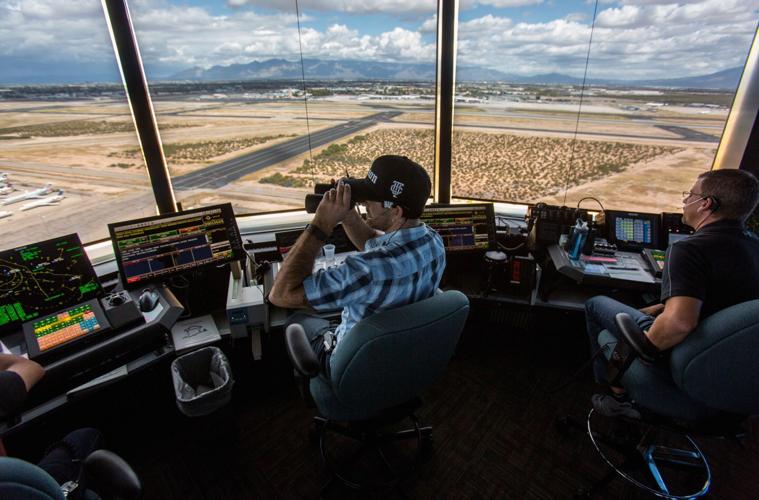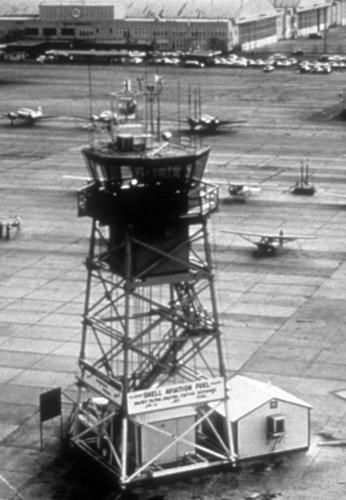The head of the Federal Aviation Administration joined local officials on Friday to dedicate a new, state-of-the-art air traffic-control tower at Tucson International Airport.
FAA Administrator Michael Huerta noted that the new tower is a vast improvement over Tucson’s old tower, which was built in the late 1950s and was too short and poorly positioned by today’s safety standards.
TIA combines a growing number of commercial flights with F-16 fighter traffic from the airport-based Air National Guard 162nd Wing, corporate jets and general-aviation operations.
“An airport like this deserves a first-class air-traffic-control tower, and that’s exactly what we have built,” said Huerta.
The new tower is 252 feet tall, nearly double the height of the old tower, and is positioned on the southwest side of the main runways to avoid afternoon glare that plagued the old tower.
“It will give our air-traffic controllers better views of the airfield, it makes it easier to see exactly where planes are on the ground and in the skies around our airport, and it also provides a more modern and comfortable work environment,” Huerta said, adding that the tower was completed under its $42 million budget and ahead of schedule.
The FAA chief also noted that the new tower and base building were not only built to be energy-efficient, but the facility generates its own power.
A 1,600-panel, 500-kilowatt photovoltaic solar array generates much of the facility’s power, while another system makes ice that is used at night to help cool the building when the solar panels aren’t generating power.
“The electric bill for this facility is about $30 a month, and our goal is to get that to zero,” Huerta said.
“We believe that investment and environmental responsibility are very much intertwined, and this tower is a shining example of our attempts to achieve net-zero energy usage,” he said.
Bonnie Allin, president and CEO of the Tucson Airport Authority, said the airport authority owns the old tower, which will be kept for offices or other uses and will continue to beckon travelers with its neon TUCSON signage.
“What better way to welcome visitors to our community as they land, than by looking out one side of the airplane window and seeing the historic, cultural icon representing Tucson and our history, and looking out the other side and seeing the newest, most state-of-the-art control tower in the country,” she said.
Allin said the airport continues to work with the FAA on airfield safety enhancements, including construction of a new taxiway and relocation and lengthening of a runway parallel to the main runway.
Tucson Mayor Jonathan Rothschild said the tower is a welcome improvement for the airport, which he called an economic engine for the region.
He said the ongoing development of land south of the airport to provide a buffer to Raytheon Missile Systems’ sprawling airport operation and to create an aerospace business corridor will help drive the economy.
He also cited a new nonstop flight to New York and new service to Mexico starting in October. “These flights will increase tourism and Tucson’s desirability as a meeting location while providing an important economic link for our region’s trade and logistics sector,” Rothschild said.
The new tower sits atop a 13,000-square-foot base building that houses computer equipment, administrative offices and a backup power system that is designed to automatically activate in case of a commercial power outage.
The tower and base building are built to LEED (Leadership in Energy & Environmental Design) Silver standards, with energy-saving features including a light-colored roof that reflects the sun’s heat, insulated windows, motion detectors for the low-energy indoor lights, and low-water-use native desert plants.
The total project cost, including computer equipment, electronics, fire-suppression systems, and heating and air conditioning, was about $40 million, the FAA said.
An FAA spokesman said information on the cost of the solar and ice-making systems and the time expected for their savings to cover their capital costs was not immediately available.
While the new Tucson tower has the latest control equipment, the airport isn’t yet in line for the so-called “Next Gen” air-traffic-control systems, which include a satellite-based navigation system, a text-based pilot communication system and other upgrades.
Huerta said those systems are being rolled out at the largest airports first.
The FAA’s Metroplex program seeks to optimize airport traffic to save time, fuel and air emissions with the use of satellite-based navigation. But the system has prompted complaints in Phoenix and other cities where it has been implemented, after planes were routed over residential areas not previously subjected to plane traffic.
The city of Phoenix and neighborhood groups are suing the FAA over the changes last September at Phoenix Sky Harbor International Airport, which resulted in thousands of noise complaints from area residents.
Huerta said the FAA is still working to address the issues while pursuing the goal of optimizing air routes.
“Those represent changes, and that means we need to work through issues with communities and the airlines, to ensure we can find that right balance between how we get the highest level of safety and efficiency and how we mitigate impacts on communities,” he said.






